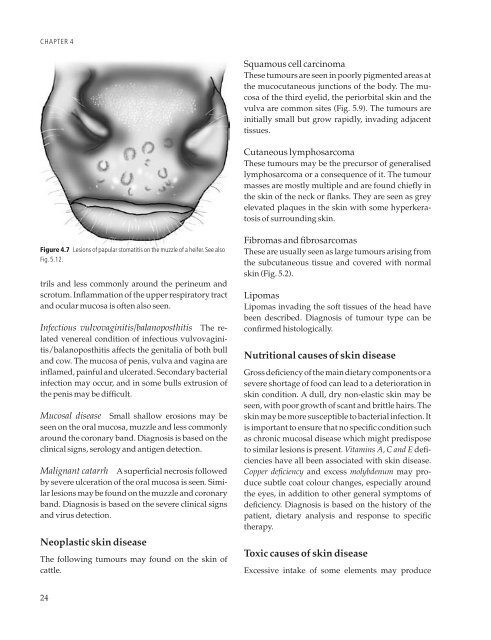Clinical Examination of Farm Animals - CYF MEDICAL DISTRIBUTION
Clinical Examination of Farm Animals - CYF MEDICAL DISTRIBUTION
Clinical Examination of Farm Animals - CYF MEDICAL DISTRIBUTION
You also want an ePaper? Increase the reach of your titles
YUMPU automatically turns print PDFs into web optimized ePapers that Google loves.
CHAPTER 2<br />
The General <strong>Clinical</strong> <strong>Examination</strong><br />
<strong>of</strong> Cattle<br />
General approach to the clinical<br />
examination<br />
The patient should always be treated humanely. A<br />
quiet word as the patient is approached will <strong>of</strong>ten<br />
help to reassure the animal and calm an anxious<br />
owner.<br />
A thorough examination <strong>of</strong> the patient should always<br />
be carried out. The consequences <strong>of</strong> not doing<br />
so can be embarrassing and potentially dangerous.<br />
Respiratory rate<br />
This should be counted over a period <strong>of</strong> 1 minute before<br />
the animal is caught or restrained for examination.<br />
Inspiratory or expiratory movements <strong>of</strong> the<br />
chest wall or flank can be counted. In cold weather<br />
exhaled breaths can be counted. If the animal is restless<br />
the clinician should count the rate <strong>of</strong> breathing<br />
for a shorter period and use simple multiplication to<br />
calculate the respiratory rate in breaths/minute.<br />
Mouth breathing is abnormal in cattle and is usually<br />
an indication <strong>of</strong> very poor lung function or a failing<br />
circulation.<br />
Normal respiratory rate in cattle<br />
• Adult 25 breaths/minute (range 15 to 30)<br />
• Calf 30 breaths/minute (range 24 to 36)<br />
Restraint for examination<br />
The animal must be restrained so that it can be examined<br />
carefully, safely and with confidence. Calves are<br />
usually held by an assistant with one arm round their<br />
necks and may be backed into to a corner. Adult cattle<br />
can be restrained in a crush if available or (less satisfactorily)<br />
behind a swing gate. Quiet animals can be<br />
held using a halter or head collar. Unhandled cattle<br />
may be caught with a lasso if no crush is available.<br />
Additional control can be achieved using bulldogs or<br />
the nose ring in the case <strong>of</strong> a bull. An antikick bar may<br />
also be useful.<br />
Chemical restraint<br />
The use <strong>of</strong> a drug such as xylazine is helpful with<br />
nervous or difficult animals, but the restrictions <strong>of</strong><br />
milk or meat withdrawal times must be observed.<br />
Detailed observation<br />
Once the animal has been restrained it should be<br />
visually examined more closely to see if any<br />
further abnormalities can be detected at close quarters.<br />
A small eye lesion that might not be spotted<br />
from a distance in an animal with pr<strong>of</strong>use epiphora<br />
(excessive production <strong>of</strong> tears) may now be readily<br />
visible. Any swelling or other lesions on the body<br />
seen earlier can now be inspected more closely and<br />
palpated.<br />
Temperature<br />
The body temperature is taken using a mercury or<br />
digital electronic thermometer placed carefully into<br />
the rectum. The thermometer should be lubricated<br />
before insertion and checked (in the case <strong>of</strong> a mercury<br />
thermometer) to ensure that the mercury column has<br />
been shaken down before use. It should be held<br />
whilst it is in the rectum. Sudden antiperistaltic<br />
movements in the rectum may pull the thermometer<br />
out <strong>of</strong> reach towards the colon. The thermometer is<br />
left in position for at least 30 seconds; the clinician<br />
should ensure the instrument is in contact with the<br />
9













